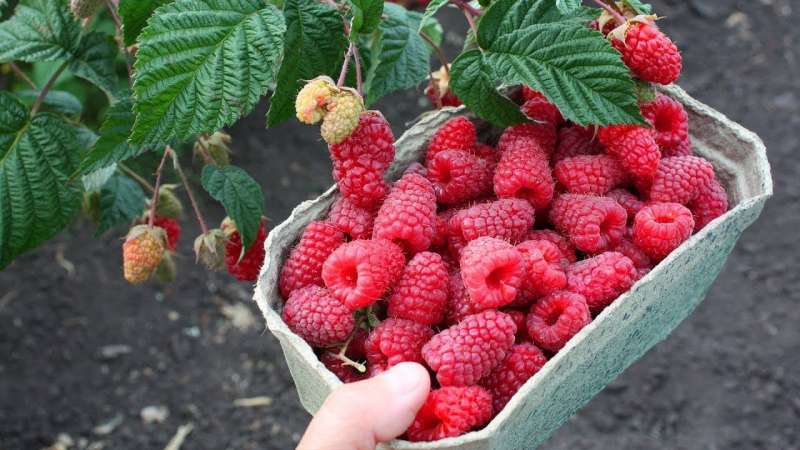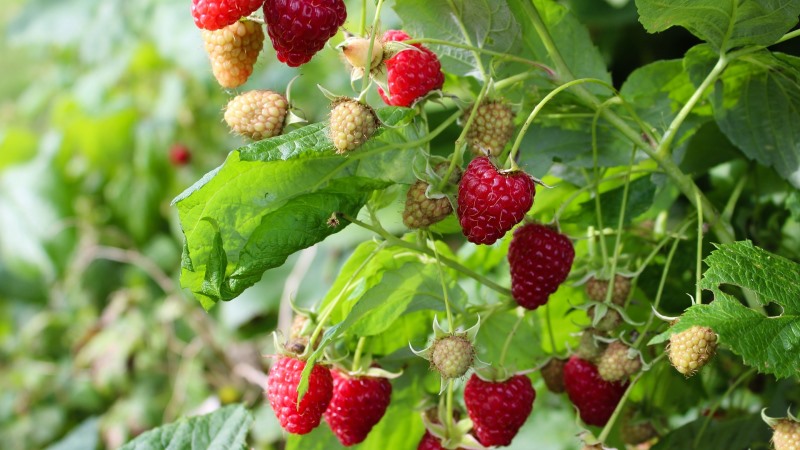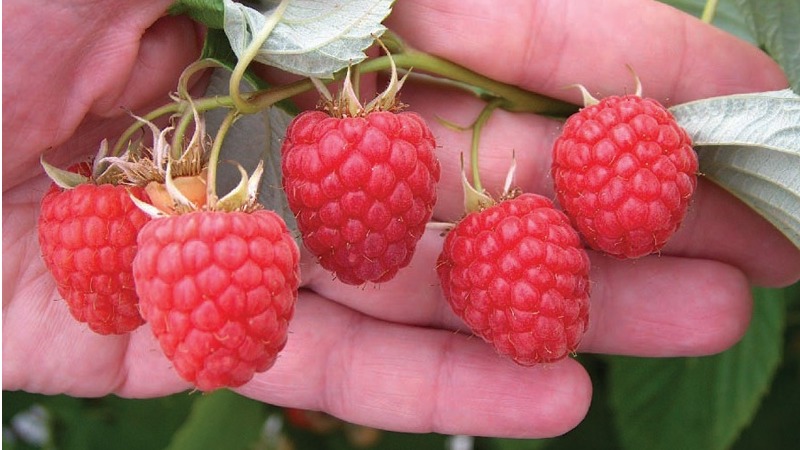The best raspberry varieties for the Urals and the peculiarities of their cultivation
To fill the pantry shelves with delicious jam and healthy compote, gardeners grow a variety of berries on their plots. One of the most beloved and popular berries among Russian summer residents is raspberry. There are red, yellow, orange varieties. Some of them bear fruit 2-3 times per season - one bush gives about 5 kg of delicious and beautiful berries. In many ways, the yield depends on the growing region. In the article, we will consider the names and descriptions of the best raspberry varieties for the Urals, we will learn the secrets of their cultivation.
The content of the article
Raspberry varieties for the Urals
The Urals has a harsh climate and changeable weather - in the morning it can be + 10 ° C and sunny, and in the evening 0 ° C and precipitation in the form of snow. Therefore, it is recommended to choose frost-resistant varieties with strong immunity.
When ripe raspberry in the Urals and what varieties to choose for landing, consider further.
The best remontant varieties

Repairing these varieties are ways to give a harvest several times per season - an early harvest is formed on last year's shoots, a late one - on newly formed ones. To get a lot of berries, gardeners follow special agrotechnical rules.
Unlike traditional varieties, which are guaranteed to ripen once a year, remontant ones require protection from weather conditions and need additional fertilizers.
The best varieties of remontant raspberries for the Urals:
- A shelf. Mid-early raspberries ripen at the end of July, bears fruit from the beginning of September. In one brush, about 10 large pink-red berries are formed. The mass of one berry varies from 3 to 5 g. The variety is versatile in application, the berries are distinguished by their rich taste and sweet aroma. Productivity from 3 to 7 kg per bush.
- Caramel. The first crop appears in early August. The variety is unpretentious in care - the main thing is to observe the watering regime. The berries are large, the weight of one can reach 6 g. The color is rich, the taste is sweet. Gardeners use fresh raspberries or use them to prepare winter preparations - they cook jams and compotes, preserves and jellies. Productivity is about 5 kg from one bush.
- Orange wonder... An original remontant variety with golden yellow berries. Bushes are small, shoots are formed at the same time. The berry weight is from 4 to 6 g, the taste is sweet and sour. The variety is distinguished by excellent transportability and long shelf life. The yield is stable - about 5 g per bush.
Varieties with large berries

Large berries are most often consumed fresh - they are juicy and sweet. They are also added to desserts - even a simple scoop of ice cream, thanks to raspberries, will turn into a beautiful and healthy delicacy.
- Eurasia. The variety is distinguished by its resistance to pests and diseases, immunity to abrupt climate changes. Great for cultivation in the South Urals. The bush grows straight up, reaching a height of 1.5 m. It blooms in July, and the berries ripen in August. One weighs about 4-5 g, conical shape. The color is dark crimson, matte. The pulp is sweet and sour, the aroma is moderate. About 3 kg of the crop is harvested from one bush.
- Penguin. About 6 kg of ripe and aromatic berries are harvested from one bush. Round-conical shape, deep red-pink color. The pulp is dense, sweet and sour, there are small bones inside. The weight of one is from 4 to 5 g. The variety is versatile in use, the crop is perfectly stored fresh and frozen.
- Golden autumn. Raspberries weigh from 4 to 7 g, berries are large, golden-orange in color.The crop has an attractive presentation, so the Golden Autumn is grown not only for personal consumption, but also for sale. The fruit tastes sweet, with a slight sourness. About 3 kg of the crop is harvested from one bush.
The sweetest
Varieties with sweet pulp are used in cooking - raspberries are dried and frozen, processed fresh. It is rich in vitamin C - the berries make tasty and healthy jam for the winter. This dessert will protect you from the flu and colds and strengthen your immune system.
- Early sweet. The large-fruited variety is ideal for growing in the Ural region - it is a little sick and bears fruit in all weather conditions. The berries are the same shape and size, the flesh is firm. The weight of one is about 5-8 g, the taste is honey, the aroma is rich. 3-4 kg are collected from one bush.
- Polana. A frost-resistant variety with a stable yield. Raspberries are grown in the shade - this will not change the number of ripe and large berries. The ripening period is extended - from the first half of July to early October. The taste and aroma are sweet, about 5 kg of the crop are harvested from the bush.
- Bell. The self-pollinated variety is drought-resistant, therefore it shows excellent yields even with minimal watering. Berries of medium size, weight of one is from 3 to 5 g. The taste is sweet-honey, without sourness and bitterness. Classic crimson color. Gardeners collect from 3 to 6 kg of ripe and beautiful berries from the bush.

Early
Early varieties are suitable for regions with short summers - they ripen quickly, do not have time to get sick. They differ in moderate fruiting, require special leaving in the form of additional dressings.
- Vera. A variety with small bushes and semi-spreading shoots. To keep the berries juicy and sweet, abundant watering is recommended. The yield is about 4 kg per bush, the taste is pleasant, the flesh is firm. Harvesting takes place in several stages - the first is the most massive. In application, Vera raspberries are universal - they like to eat them fresh and processed.
- Shiny. Compact berries with sweet and sour taste. The bushes are medium-sized, the shoots are strong. The pulp is slightly watery, the aroma is bright. Raspberries hang on branches for a long time, do not crumble. The crop is harvested 4-6 times per season. Shiny is resistant to diseases and pests, shows a stable yield.
- Patricia. A popular variety among all gardeners. The pulp is tender and sweet, the weight of one berry is about 5 g. The color is bright red, the shape is slightly cylindrical. Productivity from 4 to 8 kg per bush. The Patricia variety is not intended for long-term storage - it does not tolerate transportation well. Fresh berries are recommended.
Mid-season

Among mid-season raspberries, there are many dessert varieties - they are ideal for cooking and decorating dishes. The berries are large, rich in color. The taste and aroma are bright.
- Monomakh's hat... The shape is pyramidal, the tip is slightly rounded. The weight of one berry varies from 7 to 20 g. The taste is sweet, with a slight refreshing sourness. The structure is dense, does not fall apart or crumble during harvest. About 6 kg are collected from the bush. The frost resistance of the variety is above average, however, in order to obtain a rich harvest, the Monomakh Hat needs additional feeding.
- Hercules. The bush is conical. The berry weight is from 5 to 15 g. The color is bright, raspberry-red. Differs in resistance to diseases and pests, unpretentious in care - suitable for growing not only in the Urals, but also in Siberia. Productivity is stable, about 5 kg per bush. Of the shortcomings, the presence of sharp thorns on the bushes is noted.
- Kuzmin's news... Great for short and cold summer regions. The berry weight is from 2 to 5 g, the aroma is weak. The taste is sweet and sour, the flesh is dense. Kuzmin's news is not suitable for long-term storage and transportation. The yield is average, gardeners collect about 3 kg of small berries from the bush.
Late

Late varieties are distinguished by large fruits and sweet taste.... They ripen by early to mid-August, and do not require special agrotechnical rules in their care.
- Diamond. Repaired raspberries are planted in sunny areas - for a rich harvest. The weight of one berry is about 7 g, the color is rich, the flesh is dense. The raspberry has a sweet taste, the shape is slightly pointed at the bottom. Diamond bears fruit until winter - it pleases gardeners with a bountiful harvest. About 4-5 kg of berries are collected from one bush.
- Polka. The variety has an appetizing appearance - large berries ripen in bunches, 5-10 pieces each. Resistant to major diseases of culture, unpretentious in care. There are few thorns on the bushes, so gardeners are not afraid to scratch their hands during the harvest. The taste is moderately sweet and juicy. Productivity 3-7 kg per bush.
- Taganka. Bushes are semi-sprawling, compact. The berry weighs 5 g, the color is bright crimson-burgundy. Raspberries are easily separated from the stalk, the pulp is not watery, the taste is rich. One bush gives up to 5 kg of harvest. In application, Taganka raspberry is universal.
Features of growing raspberries in the Urals
To get a tasty and rich harvest, it is recommended to follow the planting and care rules. Each stage is important - seed preparation, site selection, planting, care requirements, protection from diseases and insect pests.
When is the best time to plant - in spring or autumn
Planting timing depends on the variety. Repaired varieties are suitable for spring planting - they have time to ripen by mid-summer and give the first harvest. How to plant raspberries in spring? The soil is prepared in advance - a month before the onset of spring. The land is cleaned of debris and weeds, dug up and loosened to get rid of hard and large lumps.
To plant common raspberries in the fall, the soil is prepared in 2-3 months. It is recommended to choose a spacious and sunny area - raspberries, like other berries, love sun and warmth. The site for raspberries should be located away from swamps, floods and groundwater. Otherwise, the risk of fungus is high.
Attention! You cannot choose for planting places where potatoes, eggplants, peppers and other nightshade crops previously grew. It is also not recommended to plant raspberries in the same place for more than 5 years in a row - the soil "gets tired", loses its vitamins and mineral components.
Landing rules
Raspberries are planted in separate bushes or rows. For the first option, holes are needed - they are made in advance and located at a distance of 1 m from each other. The roots of the bush are moistened in a mullein solution and lowered into the hole, sprinkled with dry earth on top and gently slapped with your palms. Recommended distance between rows is 2 m.
For the second method of planting, a trench of 45 x 50 cm is prepared. The distance between the bushes should be at least 50 cm. The trench is filled with a nutrient mixture - double superphosphate and liquid mullein are perfect.
It is early to add nitrogenous elements at the planting stage - they can negatively affect the development of young bushes. The seedlings are placed in a trench, sprinkled with earth and sprinkled with humus.
Care features
The main stage of care is proper watering. It is not recommended to give the plant too much moisture - this will lead to the development of rot and disease. The optimal watering schedule is once every 20 days, in dry weather - once every 15 days. Before each wetting, gardeners loosen the soil, this nourishes the roots and stimulates their development. When loosening, it is important not to damage the root system - to sink into the ground no more than 5 cm.
2 years after planting, gardeners apply mineral fertilizers to the soil. They pay particular attention to nitrogen-containing dressings - raspberries do not tolerate their absence. It is also recommended to water the bushes with a solution of liquid mullein or burdock infusion once a month. These simple remedies strengthen the plant's immune system and protect against insect pests.
Attention! The shoot garter plays an important role in grooming. It is carried out so that the bushes do not break under the weight of the fruit.The fan-shaped method is widespread - between the bushes they drive in for a trellis, to which part of the shoots of one and the other bush is tied at different heights. Outwardly, this design looks like a fan.
When berries ripen in the Urals
Early and mid-season varieties ripen by mid-July-early August. They have a long fruiting period - they feast on ripe berries until early October.
Late varieties ripen by mid-August and continue to bear fruit until the first frost - in the Urals, this is mid-October. It is important not to overexpose ripe berries on the bushes - the branches break under their weight. Experienced gardeners pick raspberries immediately after they have gained color and shape.
When transplanted
Raspberries transplanted every 5-6 years. This increases the yield, flavor and appearance of the berries. Gardeners do this in the spring, summer or fall - there are no strict rules or restrictions.
It is recommended to plant raspberries in the garden where onions, herbs or legumes were previously grown. Choose a trench or single (bushes) type of planting. Seedlings are transplanted, covered with earth and mulched. In order for the plant to quickly adapt to a new place, it is sprayed with a solution of wood ash from a sprayer.
Conclusion
For growing in the Urals, gardeners choose varieties that are resistant to weather changes. These are raspberries Eurasia, Diamond, Shiny, Shelf. For planting, choose a sunny and spacious area, away from underground and groundwater.
Berries are planted in rows or bushes, after digging up the ground and removing debris. Raspberries love mineral fertilizing - especially with nitrogen-containing components. It ripens by July or August - the timing depends on the variety. Most varieties are suitable for fresh consumption, for preparing dessert dishes, preserves and compotes.